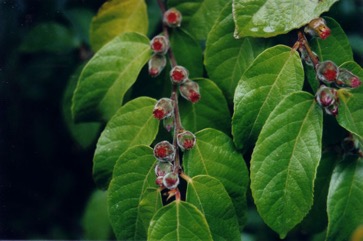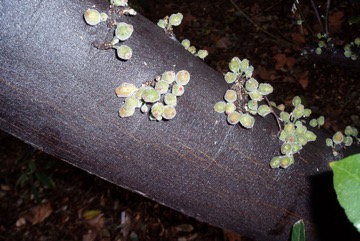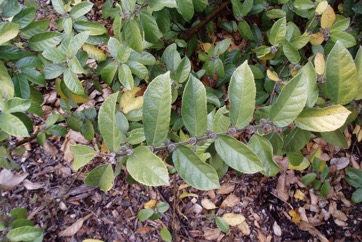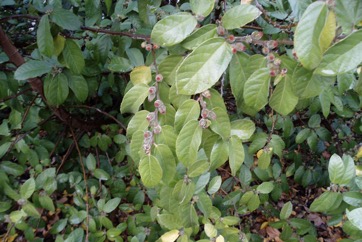Creek Sandpaper Fig, Creek Fig

A tropical plant. They grow in subtropical and warm temperate locations. In tropical Queensland it grows between 500-600 m altitude. It needs well drained soils. It can grow in sun or shade. It often grows along creek banks. It suits hardiness zones 9-11. Adelaide Botanical Gardens. Arboretum Tasmania.
Synonyms
- Ficus stephanocarpa Warb.
Edible Portion
- Fruit
Where does Creek Sandpaper Fig grow?
Found in: Australia, Tasmania
Notes: There are about 800-1000 Ficus species. They are mostly in the tropics. There are 120 Ficus species in tropical America.
Growing Creek Sandpaper Fig, Creek Fig
Cultivation: Plants can be grown from seed or cuttings. The seed are removed from the fig and mixed with sand before sowing as they are very small. Take the seed from ripe purple-black fruit. The plant needs a small wasp to fertilise the fruit.
Edible Uses: The fruit are eaten when fully ripe. They are good flavour but dry and can be stewed with sugar and water. The hairy skin needs to be removed.
Nutrition Info
per 100g edible portion| Edible Part | Energy (kcal) | Protein (g) | Iron (mg) | Vitamin A (ug) | Vitamin c (mg) | Zinc (mg) | % Water |
|---|---|---|---|---|---|---|---|
| Fruit | - | 0.4 | - | - | - | - | 67.5 |
Creek Sandpaper Fig, Creek Fig Photos




References
Bodkin, F., 1991, Encyclopedia Botanica. Cornstalk publishing, p 472
Caton, J.M. & Hardwick, R. J., 2016, Field Guide to Useful Native Plants from Temperate Australia. Harbour Publishing House. p 194
Cherikoff V. & Isaacs, J., The Bush Food Handbook. How to gather, grow, process and cook Australian Wild Foods. Ti Tree Press, Australia p 162, 195
Cooper, W. and Cooper, W., 2004, Fruits of the Australian Tropical Rainforest. Nokomis Editions, Victoria, Australia. p 323
Costerman, L., 1981, Native Trees and Shrubs South East Australia, 150, 151
Cribb, A.B. & J.W., 1976, Wild Food in Australia, Fontana. p 35
Cronin, L., 1989, The Concise Australian Flora. Reed. p 158
Elliot, W.R., & Jones, D.L., 1992, Encyclopedia of Australian Plants suitable for cultivation. Vol 4. Lothian. p 282 (Drawing)
Etherington, K., & Imwold, D., (Eds), 2001, Botanica's Trees & Shrubs. The illustrated A-Z of over 8500 trees and shrubs. Random House, Australia. p 327
Flora of Australia, Volume 3, Hamamelidales to Casuarinales, Australian Government Publishing Service, Canberra (1989) p 59, 61
Greig, D., 1996, Flowering Natives for Home Gardens. Angus & Robertson. p 181
Hardwick, R.J., 2000, Nature's Larder. A Field Guide to the Native Food Plants of the NSW South Coast. Homosapien Books. p 106
Haslam, S., 2004, Noosa's Native Plants. Noosa Integrated Catchment Assn. Inc. p 337
Hibbert, M., 2002, The Aussie Plant Finder 2002, Florilegium. p 101
Hiddins, L., 1999, Explore Wild Australia with the Bush Tucker Man. Penguin Books/ABC Books. p 160
Jard. St. Sebastien 29. 1818
Jones D, L, 1986, Ornamental Rainforest Plants in Australia, Reed Books, p 218, 340
Lazarides, M. & Hince, B., 1993, Handbook of Economic Plants of Australia, CSIRO. p 114
Low, T., 1991, Wild Food Plants of Australia. Australian Nature FieldGuide, Angus & Robertson. p 83
Low, T., 1992, Bush Tucker. Australia’s Wild Food Harvest. Angus & Robertson. p 64
McKerney, M. & White, H., 2011, Bush Tucker, Boomerangs & Bandages. Border River-Gwyder Catchment Management Authority p 53
Melzer, R. & Plumb, J., 2011, Plants of Capricornia. Belgamba, Rockhampton. p 204
Nicholson, N & H., 1996, Australian Rainforest Plants 2, Terania Rainforest Publishing. NSW. p 29
Ratcliffe D & P., 1987, Australian Native Plants for Indoors. Little Hills press. p 89
Recher, P, 2001, Fruit Spirit Botanical Gardens Plant Index. www.nrg.com.au/~recher/ seedlist.html p 6
Ryan, M. (Ed.), 2003, Wild Plants of Greater Brisbane. Queensland Museum. p 269
White, G., 2008, The Bush Tucker Survival Guide. https://www.survival.org.au
Williams, J.B., Harden, G.J., and McDonald, W.J.F., 1984, Trees and shrubs in rainforests of New South Wales and Southern Queensland. Univ. of New England, Armidale. p 64, 67
Yallakool Reserve Plant List July 1, 2009 Off internet